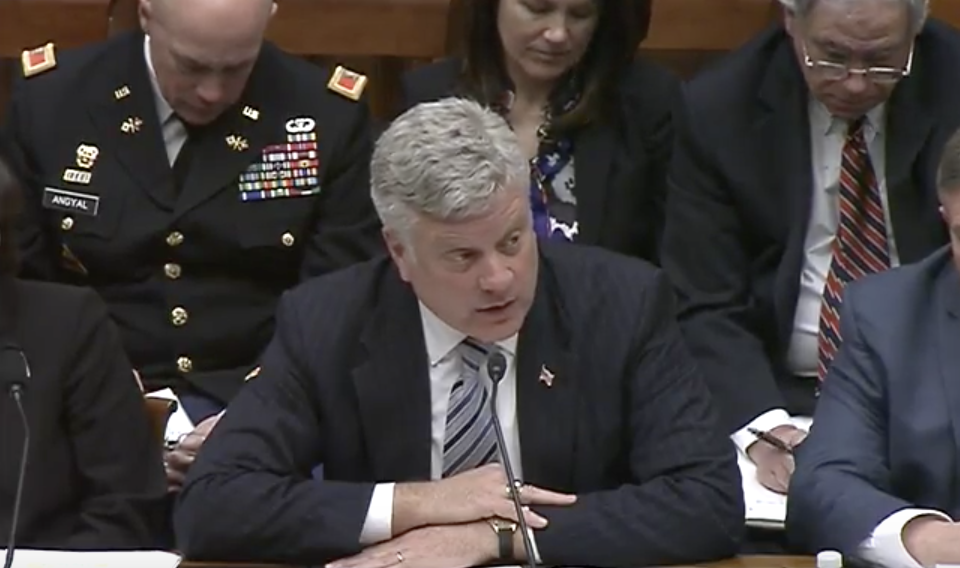
DARPA ?Director Steven Walker testified to members of the emerging threats and capabilities subcomittee of the House Armed Services Committee on Wednesday. Screenshot photo.
The director of the Defense Advanced Research Projects Agency said his artificial intelligence focus today is machines responding to new environments and information, what he called “third generation” AI.
Second generation AI, DARPA boss Steven Walker explained, is the more basic machine learning, or machine “training,” by which computers are taught to independently recognize a building, for example, so they can find one in a video feed. The next step is getting the computer to explain why it’s identified a building and not just doing so. This is important when, on the battlefield, changing variables like an unidentified adversary aircraft, may not exactly meet the conditions originally fed into a computer. What if a plane has three wings, for example. Will that trip up the machine-taught AI
“When a piece of data changes, how does the machine get to that?” Walker asked, testifying to the House Armed Services Committee’s Emerging Threats and Capabilities Subcommittee.
Mary Miller, who’s currently performing the duties of Assistant Secretary of Defense for Research and Engineering, said she expects the Defense Department’s budget to more heavily focus on science and technology in the future. She acknowledged today the major focus is readiness, which is in line with President Don?ald Trump’s National Defense Strategy.
“We could do with more,” she told the subcommittee about monies allocated to various S&T initiatives, from hypersonics to the aforementioned development of AI.
In her opening statement, Miller emphasized a looming danger her colleagues on the witness bench would repeat throughout the testimony.
“China and Russia are at parity or surpassing the US in the range, speed, and lethality of some of our weapons and platforms. We are now on-par or outranged by Russian and Chinese rocket and artillery capabilities,” she said. “China and Russia can hold US and allied positions at risk—amplifying capabilities to detect, track, and target threats in varying conditions, larger volumes, and at greater distances, extend China’s integrated air defense systems.”
To counter this, the services are leaning into prototyping and experimenting in new and novel ways, attempting to field new capabilities faster than ever.
Jeffrey Stanley, deputy assistant secretary of the Air Force for science, technology, and engineering, said USAF recognizes it’s not the country that innovates the best that will win, but rather the one that applies that innovation the fastest.
“It’s not only the technologies,” he said, “but the pace in which the Air Force innovates and responds to them.”
In September 2017, Air Force Secretary Heather Wilson announced a year-long science and technology review for the service.
“The Air Force must reinvigorate its focus on basic and applied research to ensure the long-term domination of air and space,” Wilson said in kickstarting the review. “We must also reevaluate how we manage our research enterprise and spend research dollars in ways that advance air and space superiority for the long term.”
The Air Force Research Laboratory, tasked with leading that effort, recently announced over a dozen opportunities for the public to present ideas to improve and innovate its products and processes. These “listening sessions” aim to let non-traditional USAF partners in the science and technology arena—really, the American public—offer ideas for innovation, explained AFRL Commander Maj. Gen. William Cooley at the announcement in Washington, D.C.
Altogether, the various approaches USAF is taking with this S&T review will work to keep the country ahead of its adversaries in the scientific realm, now and decades into the future.
“I view this through a much broader security lens,” Cooley said in late 2017, following Wilson’s announcement. “This is about our United States Air Force and how we’re going to ensure we maintain our technological edge.”
This hopeful introspection, eagerness to change from within, and the world innovation tour are examples that set this S&T project apart from other studies. Collectively, the hope is to integrate more agents of change into the Air Force S&T efforts.